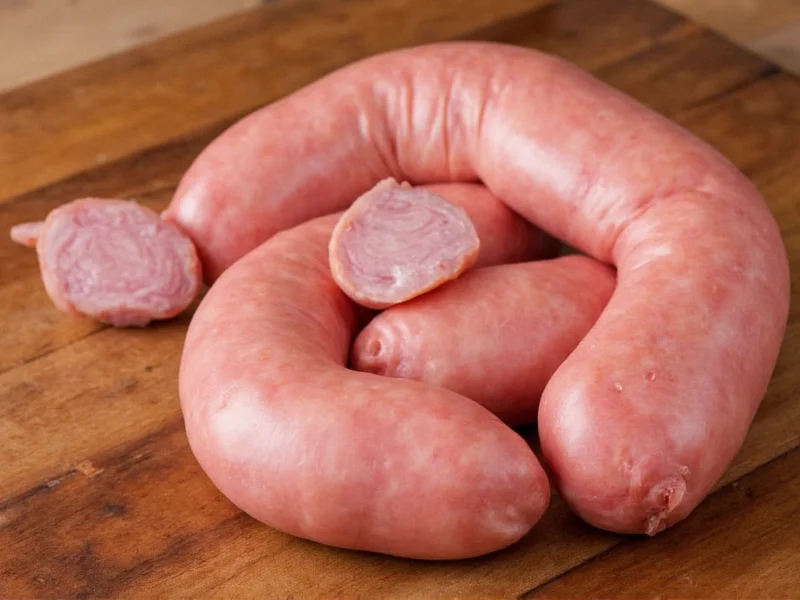Sausage casings serve as the essential outer layer that shapes and contains sausage meat during cooking. Understanding what sausage casings are made of helps both home cooks and commercial producers select the right type for their specific needs. This comprehensive guide explores the materials, manufacturing processes, and practical considerations for all major casing types.
Natural Casings: Tradition Meets Texture
Natural casings, the original sausage containers, come from the submucosa layer of animal intestines—primarily from pigs, sheep, and cattle. Hog casings (typically 32-35mm diameter) work best for breakfast links and bratwurst, while delicate sheep casings (18-24mm) suit thin sausages like hot dogs. Beef casings, including middle and bung varieties, handle larger diameters for salami and summer sausage.
The production process involves thorough cleaning, scraping, and salt-preservation of intestines. This traditional method creates casings with uneven texture that many chefs prefer for authentic "snap" when biting. Natural casings are fully edible and biodegradable, though they require careful handling due to variable sizing and perishability. When exploring what are hot dog casings made of historically, sheep casings represent the classic choice that delivers that distinctive pop.
Collagen Casings: Consistency and Convenience
Modern collagen casings, derived from processed cattle hides, offer remarkable uniformity compared to natural options. Manufacturers extract collagen proteins, then reform them into edible tubes through extrusion. These casings come in two varieties: edible collagen (25-40mm) for fresh sausages, and inedible collagen (35-120mm) designed for peeling after cooking large products like turkey breasts.
Home sausage makers often choose collagen casings for best casing for homemade sausages due to their consistent diameter, ease of use, and longer shelf life. Unlike natural casings, collagen tubes maintain uniform size throughout, reducing filling complications. They provide good smoke absorption and moderate elasticity, though they lack the authentic texture of natural options. Most importantly, they answer the common question are sausage casings edible with a clear yes for the edible varieties.
Cellulose Casings: The Hot Dog Standard
Synthetic cellulose casings, made from regenerated plant fibers (typically wood pulp or cotton linters), dominate commercial hot dog production. These thin, transparent tubes allow for precise diameter control (18-22mm for standard hot dogs) and exceptional strength during high-speed filling. The manufacturing process involves dissolving cellulose in alkali, then extruding it through a spinneret into an acid bath that reforms it into a tube.
Most cellulose casings are designed for peeling after cooking—this explains why many store-bought hot dogs appear casing-free. However, some thin cellulose varieties remain on the product. Their uniformity makes them ideal for mass production, addressing the specific query what are hot dog casings made of in commercial settings. They provide excellent smoke penetration and consistent appearance but lack the traditional texture of natural casings.
Fibrous Casings: For Large Format Sausages
Fibrous casings combine cellulose with reinforcing paper fibers to create exceptionally strong containers for large sausages like salami, bologna, and cooked hams. These casings withstand high filling pressures and long curing periods. The paper reinforcement provides structural integrity while the cellulose layer allows smoke and seasoning penetration.
Available in diameters from 40mm to over 150mm, fibrous casings often feature printed patterns or brand information directly on the casing. Unlike other types, they're always removed before consumption. When considering difference between collagen and cellulose casings, fibrous represents a specialized cellulose variant engineered for maximum strength rather than edibility.
| Casing Type | Material Source | Edible? | Best For | Key Characteristics |
|---|---|---|---|---|
| Natural | Animal intestines | Yes | Artisan sausages, bratwurst | Authentic snap, variable sizing, perishable |
| Collagen | Animal hides | Edible varieties yes | Hot dogs, breakfast links | Uniform size, consistent texture, longer shelf life |
| Cellulose | Plant fibers | No (peelable) | Commercial hot dogs | Thin, strong, excellent smoke absorption |
| Fibrous | Cellulose + paper | No | Salami, bologna, large sausages | Reinforced strength, printable surface |
Selecting the Right Casing for Your Needs
Choosing appropriate casings depends on several factors beyond just what is sausage casing made of. Consider these practical elements:
- Sausage type: Fresh sausages typically use natural or edible collagen, while smoked products often employ cellulose
- Cooking method: Grilled sausages benefit from natural casings' snap, while boiled products work well with collagen
- Production scale: Home cooks often prefer natural or collagen for small batches, while commercial operations rely on cellulose
- Texture preference: Natural casings provide traditional mouthfeel, while synthetics offer consistency
For beginners exploring how sausage casings are manufactured, starting with pre-flushed, salted natural casings or ready-to-use collagen tubes provides the gentlest learning curve. Always match casing diameter to your sausage stuffer tube and intended product size—using 32mm casings for 26mm sausages creates frustrating air pockets.
Environmental and Dietary Considerations
As sustainability concerns grow, understanding natural sausage casing materials becomes increasingly relevant. Natural casings represent upcycled byproducts of meat processing, making them inherently sustainable. Collagen and cellulose casings, while not animal-derived in the direct sense, still connect to industrial meat and forestry operations.
Vegans and vegetarians should note that traditional sausage casings aren't plant-based, though some manufacturers now offer alginate-based vegetarian casings. When examining sausage casing ingredients for dietary restrictions, always verify with producers as some collagen casings may contain trace dairy elements from processing.











 浙公网安备
33010002000092号
浙公网安备
33010002000092号 浙B2-20120091-4
浙B2-20120091-4